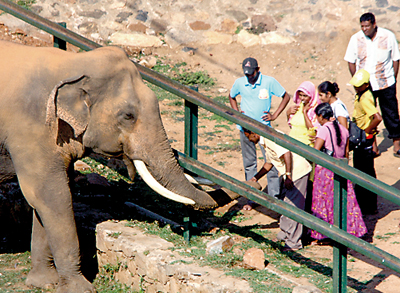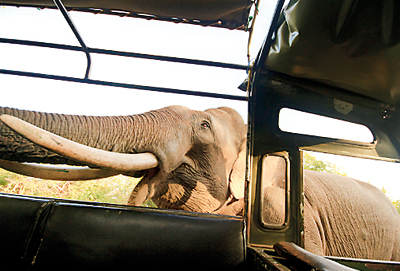News
Feeding wild elephants is high-risk entertainment
View(s):By Malaka Rodrigo
Yala’s iconic tusker Gemunu has developed bad habits after being encouraged by visitors who tempt the animal with food and other tidbits. Gemunu comes to the road, stops Safari Jeeps and dips his trunk into the vehicles jeep in search of snacks.

Disaster waiting to happen: Visitors to Sithulpawwa feed an elephant. Pic courtesy Aruna Seneviratne
Wildlife lover Riaz Cader had a closer encounter with Gemunu on December 29, when the tusker went from jeep to jeep, sticking his trunk into vehicles looking for food and biscuits. It was an exciting up-close encounter, the closest Riaz has ever been to an elephant in the wild. But this is a potentially lethal situation, and an accident is waiting to happen, Riaz warns.
“Gemunu seemed harmless, but many guests and Jeep drivers looked nervous,” Riaz said. “Tourists who pat the tusker on the back as he walks past don’t realise the danger.”
Gemunu. who is about 20 years old, has moved closely with humans from his adolescent jumbo days. It is claimed that the elephant would frequent a hotel at the edge of Yala to forage for food leftovers. In the early days, visitors and staff would give it snacks. The elephant even broke into the kitchen when the hotel management changed and no one was throwing it snacks.
Gemunu stopped visiting after strict no-feeding rules were laid down. Frequent Yala guests say Gemunu started approaching safari Jeeps about a year ago.
Wildlife biologist Manori Gunawardane, a regular at Yala, also had a close encounter with Gemunu. She was there last Tuesday when the tusker came up to their Jeep and started pushing bags around with his trunk. Empty biscuit cartons might have caught his attention. Manori slapped Gemunu on the trunk while the others shouted to scare the animal away.

Yala : Gemunu snifs at some food in Riaz Cader's jeep. Pic courtesy Riaz Cader
“The best thing you can do is avoid the elephant,” advised elephant biologist Dr. Prithviraj Fernando. “If you see him in the distance, turn around and drive off. Also, seal or tie up any boxes or bags containing food. The elephant gets interested the moment it gets a whiff of food. Elephants are intelligent. In Udawalawe, you see jumbos lining up along the fence by the road. They are waiting for food, but they don’t invade the Jeeps.”
Another tusker visits the Sithulpawwa Temple inside the Yala game reserve. Visitor Aruna Seneviratne has taken photographs of pilgrims feeding the tusker, despite warnings not to. The tusker, named Anuradha, has attacked Jeeps.
“The Jeep drivers should be blamed for this,” says Tharindu Jayasinghe, secretary of the Yala Safari Jeep Owners’ Association. “The drivers encourage the elephants by going close so that visitors can feed them,” he told the Sunday Times.
Feeding wild animals is considered a meritorious act in this country, but there is a risk. At least two Yala elephants were killed last year when they came too close to humans.
Follow @timesonlinelk
comments powered by Disqus

















